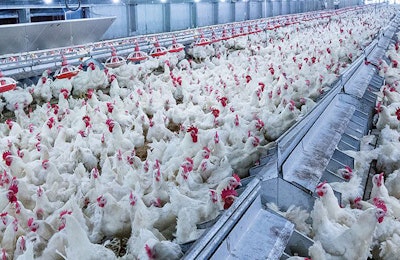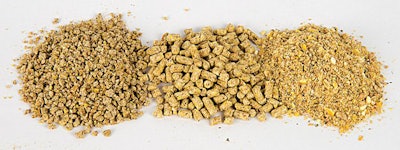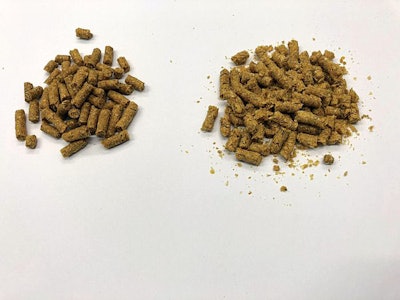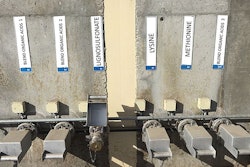
Broiler production is one of the agricultural production segments to have experienced the greatest changes over recent decades. This development has been brought about by market growth and the huge progress that has been made in production performance and efficiency. The primary objective is to reach the targeted slaughter weight within a minimal growth period while considering flock uniformity, animal welfare and environmental issues.
Productivity mainly depends on the feed intake and production performance of the birds, and can be optimized by adapting the feed form and particle size.
Common feed forms in animal feed are pellets, crumbles or mash. However, in the broiler industry, pellets and crumbles are mainly used. In less intensive areas, mash production for broilers is common too. Furthermore, the size of the single particles is a crucial factor that influences bird performance and health, independent of the feed form.
Feed intake regulated by feed form and pellet quality
Although the feeding behavior of birds can be challenging to take into account in feed production, it also provides an opportunity to control feed intake. Pelleted broiler feed has various advantages such as decreased feed wastage and improved feed hygiene. However, the most important difference compared with mash feeds is increased feed intake.
Chickens prefer to pick coarse particles, and this is observed at all ages. Regarding feed intake, one pellet is equal to one particle, regardless of the size. This fact has different consequences:
- Broilers receive more energy and nutrients at the same time when fed with pellets. Because feed intake is time-limited, this is an important factor to consider when maximizing feed intake, especially in young birds.
- Chickens choose particles by form, color, size and consistency. A more uniform diet and a narrower range of particle sizes reduce the time spent searching for and selecting larger particles.
- Preferred particles, such as coarse corn, cannot be segregated in pellets like they can in mash. This results in a more balanced supply of nutrients because sufficient intake can be ensured, including minor components such as additives with a different density, like minerals (heavy) or fibrous components (light).

Different feed forms with the same nutrient composition (from left to right: crumbles, pellets, mash). Broilers choose feed particles by form, color, size and consistency and prefer feed that is easy to pick like crumbles or pellets. (Courtesy Buhler Group)
Due to the higher feed intake, performance is increased when animals are fed pellets compared with mash feeding which explains why the majority of broiler feed is pelletized. Therefore, it is also necessary to compare the different pellet qualities which are measured in percentage of fines. Performance is the same in broilers fed with poor-quality pellets as those fed with mash. Feed intake, body weight gain and feed efficiency are lower compared with broilers fed with high-quality pellets especially at later ages. In terms of pellet quality, it is important to differentiate between evaluations carried out at the feed mill and those carried out before consumption as, during transportation and handling, frictional forces decrease the quality of the pellets. The provision of high-quality pelleted feed is essential to achieve maximum feed intake and high animal performance.

High pellet quality (left) results in increased feed intake, body weight gain and feed conversation rate compared with poor pellet quality, which has a high amount of fines (right). (Courtesy Buhler Group)
Particle size influences gizzard development, digestion
In addition to feed form, the particle size of the raw materials in the pellets also has an influence as the pellets dissolve in the crop. The reason is that the gizzard of broilers has the same function as a roller mill, grinding the feed into smaller particles.
Coarse particles in the feed stimulate gizzard activity, which results in improved grinding and gizzard development, as well as longer residence times, increased stimulation of digestion and improved body weight gain.
In contrast, fine particles cause diverse health issues, such as poor gut motility, swollen proventriculus, poor water and electrolyte reabsorption, increased feather picking or increased susceptibility to enteric pathogens. However, apparent nutrient digestibility values can be positively affected by reduced feed particle size, whereas apparent metabolizable energy was not affected.
Ileal starch digestibility values were 95% to 98% for corn, demonstrating that the differences were minor. Taking all aspects into account, with the exception of younger birds, a coarse particle size in broiler feed provides greater benefits in terms of performance and health.
For young birds, on the other hand, finer granulation is required, due to their still underdeveloped digestive system. Therefore, it is reasonable to increase the preparation of nutrients and reduce the particle size in order to improve nutrient absorption in young animals.
The influence of process parameters
The main target of the grinding process in broiler feed production is to create coarse granulation with a particularly narrow particle size distribution. One way of achieving this is to use a roller mill. The particles produced in this process have a narrow distribution and are irregularly shaped, which means there is a large surface area while still ensuring coarse granulation.
Although the milling process certainly has an influence on bird performance, average particle size and particle size distribution have an even greater impact.
Particle size is further reduced during the pelleting process. The coarser the initial granulation, the greater the particle size reduction in the pellet mill, which is why considerable reduction is expected in broiler feed. Particle size distribution is narrower than it was before pelleting.
Guideline values for particle size in broiler feed
The optimum particle size for broilers is influenced by the feed form, age and sex of the animal, its state of health and the raw materials used.
The optimum particle size for corn-based feed is coarser than wheat-based feed. For mixed starter flocks, the appropriate average particle size is in the range of 900 to 1,100 microns, whereas older birds prefer particles of between 1,100 and 1,500 microns.
For male birds, the optimum particle size is coarser than for females.
Generally, it is recommended to start with finer granulation and increase the particle size throughout the growth period.
Key takeaways
Due to the feeding behavior of broilers, the provision of pelletized or crumbled feed is recommended in order to achieve higher feed intake, avoid segregation and minimize feed wastage.
Furthermore, good pellet quality increases animal performance particularly at later ages. Coarser granulation slightly reduces nutrient digestibility, but improves gizzard activity and animal performance — thus outweighing the effect of reduced metabolizable energy.
Using a roller mill produces coarser granulation and narrower particle size distribution. Bird physiology, the digestive system and feed processing aspects, such as mill type and process parameters, should be taken into account when defining the final particle size. Finally, grinding has the greatest influence on particle size.
Editor’s note: This is the second installment of a five-part series, “All about particle size: the influence of feed particle size on animal performance,” contributed by the Buhler Group. It aims to explain the importance of particle size in pig and broiler feed, and explore the possibilities for modifying and controlling particle size during feed processing.

















